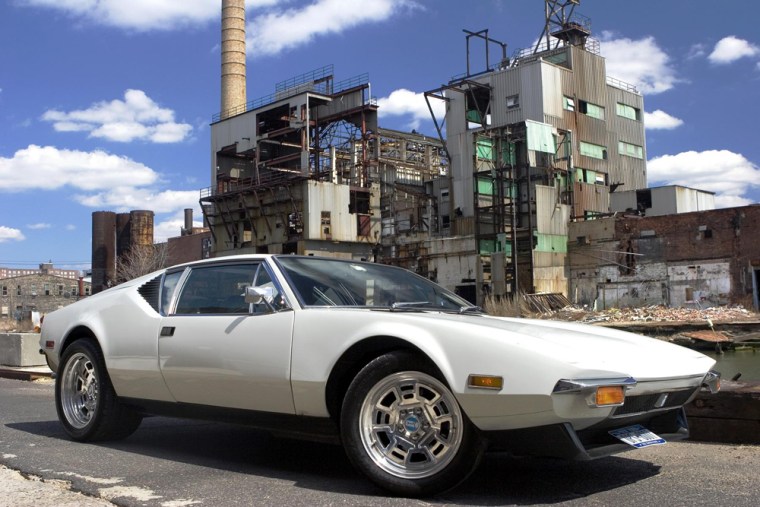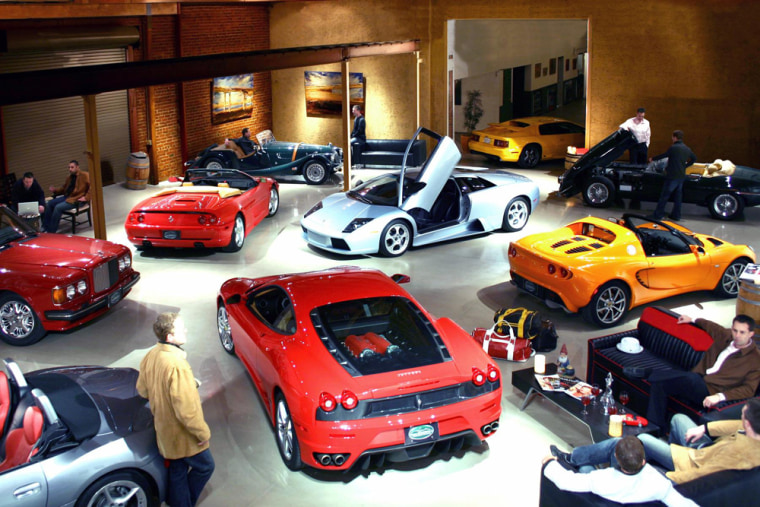George and Kathy Kiebala’s supercar-centric lifestyle, based as much on logic as passion, started about a decade ago with an Alfa Romeo they wanted to store when not racing it. Kathy, a CPA, calculated the storage cost and suggested they buy a warehouse and rent space to other car owners. Once that was up and running, they realized most of the cars in storage languished undriven, an epiphany that lead them to start Exotic Car Share Club in Palatine, Ill., in 2000.
One of the nation’s first such clubs, it offers members the opportunity to drive Dodge Vipers, Ferraris, Porsches and classic muscle cars on a pay-per-use plan following a $250 annual fee. The base price for a drive is $330 a day for a three-day weekend, or $214 a day for a full week. The most exotic rides, like Ferraris, boost rates by $150 and $100 a day.
As of early 2007, there are nearly a dozen sports-car clubs in the country that use a fractional or timeshare ownership model popularized with yachts, jets and vacation homes. All offer members the chance to drive some of the world’s most lusted-after automobiles without squelching that passion with the worries of ownership. Many of the people who join the clubs have owned an exotic car in the past. Or, they could afford one if they wanted to allocate resources that way. All understand the downside of keeping a Ferrari F355 happy and screaming.
“Fixing them is not fun. Have it break and shuttling it to the shop isn’t fun,” says car buff Keith Wolters, who founded the Premier Car Club in Salem, N.H. “The fun part is when you hop in and turn the key and it goes like it’s supposed to.”
“I have seen a lot of the headaches that exotic car owners go through,” says Collin Smith, a Bay Area resident who works in finance. And that’s the rational explanation of why Smith joined San Francisco’s Club Sportiva, which also operates in Silicon Valley, Calif. The other reason was the first sight of the club’s 1969 Jaguar convertible XKE, a classic racing green two-seater with a long louvered hood.
Soon after joining Club Sportiva, whose annual fees range between $3,500 and more than $18,000, he booked the club’s 1982 Morgan Plus 8 for the week of his Napa wedding. He takes one of the two Bentleys to the opera and up to wine country when he wants room for another couple. “We try and find what’s appropriate,” Smith says. Some outings, that’s the orange 2005 Lotus Elise. Other times it’s the red 2003 Maserati Spyder.
An unexpected result is that Smith realized he didn’t need anything fancy or extravagant in his own garage. In fact, he commutes in a Honda Civic that he can mile-up and not worry about. “I have the club, and it satisfies that desire,” Smith says.
That’s what keeps these clubs multiplying. Most operate on a point system and have varying deductions for each type of car, day of the week and length of time used. Some have a pay-per-ride scale.
Curvy Road, an offshoot of Exotic Car Share near Chicago, offers fractional ownership, which means owners get a share of the selling price. Among the clubs are the Classic Car Club of Manhattan, the Otto Club in the Boston area, Privatus, in Charlotte, N.C., the Van Horssen Group in Scottsdale, Ariz., and Velocity, which opened on April 4 in Greenwich, Conn., a town synonymous with wealth long before hedge-fund managers settled there. Such was the demand that Chris Maybury, one of Velocity’s founding partners, signed up potential members at the opening party. Among the 15 cars on display was a rare Aston Martin DB9.
To drive that car or the club’s Porsche Carrera GT and Mercedes SLR McLaren, applicants must provide character references and pay a $3,500 initiation fee, then a $28,500 annual fee. The club figures that two years of membership would cost $69,260 and save $150,700, compared to buying that Porsche for $455,000, only to pay taxes, maintenance and interest while watching it depreciate in value $320,000.
Numbers like that are a huge selling point and a key reason for the burgeoning numbers of clubs nationwide. “The economics work out well,” says John Caron, founder of the Otto Club. This includes insurance that varies from state to state, but most often uses the member’s policy as the primary protection.
Scott Hoover, president of the Atlanta Driving Club, did some research nationwide and found that people who owned what he called “weekend cars” drove them an average of 40 days a year. That makes the Atlanta club, which has three levels of membership from $6,000 to $16,000 annually, a solid value for drivers looking to take weekend jaunts in exotic cars.

Jamie Cheng, founder of the Helium Report luxury market research firm, suggests that anyone considering a club membership go beyond getting info on the number and models of cars. He says prospective members should ask about availability, so they’ll know how likely it is they’ll get the car they prefer at the time they want it. He also recommends getting a clear understanding of exactly what comes with membership. What are the extra charges? Is the club more about the cars or the club program? “Some are places to hang out, like cigar clubs were 10 years ago,” he says.
Joining one of these clubs isn’t necessarily easy. Most rely on word of mouth to find new members. All the clubs put prospective members through an extensive application process. At Club Sportiva, not only does the club check driving records, but staff members interview applicants to determine their expectations and predict whether they’ll fit in with the group, says Torbin Fuller, the club’s founder.
Picking the right people keeps everyone happy. “You want like-mindedness,” says Otto's Caron. Give them what they want, and more enthusiasts join. He didn’t plan on having a cigar room in the clubhouse, but members thought it would be great, so now there is one.
When the group clicks, “it’s great,” says Stephen Doherty, a Premier Car Club member who lives in Andover, Mass. He says he enjoys the camaraderie of the club almost as much as driving the Hummer or the Lamborghini.
Club Sportiva coordinates wine tastings, scotch and cigar nights, go-carting expeditions, quarterly road rallies, poker nights and events like a private tour of the Tesla headquarters. At all the clubs, concierge services are the norm: Tickets to sporting events, travel arrangements, car services and even dry cleaning pick-ups are offered. Sportiva also operates an auto brokerage, buying cars for members for about 1 percent above cost, then handling all the paperwork and delivery arrangements.
Almost all the clubs solicit member opinions before buying new cars. In Atlanta, the debate is between a late 1960s Pontiac GTO or Chevrolet Camaro convertible. “I think the GTO is in the lead right now,” Atlanta's Hoover says. In Greenwich, there are discussions about a chauffeur-driven Bentley.
Another universal feature is driver training. A trip to driving school, if not required as part of joining, is strongly encouraged. “A Lexus is not a Lamborghini,” Sportiva's Fuller says. Before each drive, Club Sportiva members receive a 45-minute tutorial on the nuances of their ride. “The goal is comfort and safety,” Fuller says. If they’re comfortable with the car, they’re safer.” In four years of operation, the club has yet to have one of its vehicles in even a minor fender-bender.
Driver training is perhaps even more important for the clubs that operate in areas where winter brings snow and ice. None of the clubs close down, but they do bundle up. The Hummer gets a workout at the Premiere Car Club. The Otto Club gives members credit for days when it snows and they must keep the car in the garage.
Suzanne Garner, a Silicon Valley software engineer, tends to wait until Northern California’s rainy winters end before exercising her Club Sportiva membership. An “Elite” member, she has access to every car in the club, and uses them. “I love cars and I love driving… I put a lot of miles on the Sportiva cars.” An enthusiastic participant in club events, Garner became the first female amateur to drive a Formula One car on a U.S. track, an opportunity that the club organized. On more ordinary weekends she takes driving trips by herself — it’s “a chance to get completely away,” she says.
Garner admits that without the club taking on the burdens of maintenance, storage and repair, driving such exotic vehicles would be less appealing. “I couldn’t manage all the work,” she says “The cars are always beautifully detailed. You just get in them, drive and have fun.”
Another way exotic car share clubs seek to optimize the enjoyment and minimize the hassles of driving supercars is by arranging tours of Western Europe in sports cars comparable to those in the home stable.
While any Ferrari owner can arrange a tour of the Maranello factory through his or her local dealer, the clubs’ forte is handling all the coordination before and during travel, thus buying time for members while assuring them of peak experiences. Befitting the level of exclusivity of the cars these clubs offer, all hotels are world-class, all meals gourmet and all problems solved, if humanly possible. Clubs will even handle all of the paperwork (purchasing, licensing and shipping) involved with carmakers’ own European delivery programs.
But true enthusiasts will most appreciate the car club staffers’ inside knowledge: On an Alpine route, Sportiva members are instructed to roll down their windows so they can hear the Ferrari’s V8 or V12 engine echo through the canyons. The route twists by the mountaintop fortress that was the villain’s stronghold in the 1969 James Bond movie “On Her Majesty's Secret Service.” Keep driving down the same Alpine road to track the chase scene involving the Aston Martin and Ford Mustang from the 1964 Bond classic “Goldfinger.”
Some Sportiva members spend as long as a month driving through Europe, says founder Torbin Fuller, but the average is a week to 10 days. The club makes route recommendations and handles all arrangements.
Take the winding roads of Italy’s Amalfi Coast or detour off the Strada Chiantigiana as it dips and twists through Tuscany between Florence and Siena. If top speed in a straight line is on your to-do list, then Germany’s Autobahn beacons between Audi, BMW and Porsche factory tours.
In September, Boston’s Otto Club is planning a six-day tour for up to 20 members and guests. The program starts in Stuttgart, with a private tour of the Porsche factory. While the exact itinerary has yet to be finalized, a Porsche factory driver is selecting the route and leading the way. In addition to driving, club members said they wanted to learn more about fine watches while in Switzerland. Private tours and presentations will be held at three houses.
European group tours are in the planning stages for members of Exotic Car Share, located in Palatine, Ill. Until then, founder George Kiebala helps members plan a trip. He also encourages local tours, such as a jaunt to the historic town of Galina, Ill.
While Austria, France, Germany and Italy are top destinations when club members vote, individual drivers also roam through France and occasionally north to Scandinavia. Insurance and red tape keeps the clubs out of scenic spots elsewhere in Europe, like Croatia, Greece and Turkey.
Of course the car share clubs offer stateside trips, too. This May, Classic Car Club will lead 20 of its members on a rally from their Manhattan home base to New Orleans in the club’s elite vehicles, taking southern back roads along the way. Classic Car Club bills the second annual trip as the “Rally to Hell” and “the ride of a lifetime.”
